Potrebujeme váš súhlas na využitie jednotlivých dát, aby sa vám okrem iného mohli ukazovať informácie týkajúce sa vašich záujmov. Súhlas udelíte kliknutím na tlačidlo „OK“.
ASTM E2956-14
Standard Guide for Monitoring the Neutron Exposure of LWR Reactor Pressure Vessels
Automaticky preložený názov:
Štandardné Guide pre sledovanie neutrónovej expozície LWR tlakových reaktorov
NORMA vydaná dňa 1.2.2014
Informácie o norme:
Označenie normy: ASTM E2956-14
Poznámka: NEPLATNÁ
Dátum vydania normy: 1.2.2014
Kód tovaru: NS-46303
Počet strán: 11
Približná hmotnosť: 33 g (0.07 libier)
Krajina: Americká technická norma
Kategória: Technické normy ASTM
Kategórie - podobné normy:
Anotácia textu normy ASTM E2956-14 :
Keywords:
damage correlations, dosimetry, dpa, exposure parameters, ex-vessel neutron dosimetry, reactor pressure vessel, retrospective dosimetry, surveillance, surveillance dosimetry, ICS Number Code 27.120.10 (Reactor engineering)
Doplňujúce informácie
| Significance and Use | ||||||||||||||||||||||||||||||
|
4.1 Regulatory Requirements—The USA Code of Federal Regulations (10CFR Part 50, Appendix H) requires the implementation of a reactor vessel materials surveillance program for all operating LWRs. Other countries have similar regulations. The purpose of the program is to 4.2 Neutron Field Characterization—The tasks required to satisfy the second part of the objective of 4.3 Fracture Mechanics Analysis—Currently, operating limitations for normal heat up and cool down transients imposed on the reactor pressure vessel are based on the fracture mechanics techniques outlined in the ASME Boiler and Pressure Vessel Code. This code requires the assumption of the presence of a surface flaw of depth equal to one fourth of the pressure vessel thickness. In addition, the fracture mechanics analysis of accident-induced transients (Pressurized Thermal Shock, (PTS)) may involve evaluating the effect of flaws of varying depth within the vessel wall 4.4 Neutron Spectral Effects and DPA—Analysis of the neutron fields of operating power reactors has shown that the neutron spectral shape changes with radial depth into the pressure vessel wall 4.5 In-Vessel Surveillance Programs: 4.5.1 The neutron dosimetry monitors used in reactor vessel surveillance capsules provide measurements of the neutron fluence and fluence rate at single points on the core midplane within the reactor, and near the vessel wall; that is, at the surveillance capsule locations (1). In actual practice, the surveillance capsules may be located within the reactor at an azimuthal position that differs from that associated with the maximum neutron exposure (or that differs from the azimuthal and axial location of the assumed flaw); and at a radial position a few centimeters or more from the flaw and the pressure vessel wall 4.5.2 Given that surveillance capsules are located radially closer to the core than the surface of the RPV, they may be shifted azimuthally away from the peak exposure location in order to limit the magnitude of the surveillance capsule lead factor. The lead factor is defined as the ratio of the fast neutron fluence at the center of the surveillance capsule to the peak fast neutron fluence at the clad – base metal interface of the RPV. One adverse effect of this azimuthal shift away from the peak is that the surveillance capsule dosimetry does not “see” the part of the core that produces the peak exposure of the reactor vessel. As a result, the surveillance capsule is unable to monitor the effect of changes in the core power distribution that are made to reduce the peak RPV neutron exposure. Another adverse effect is that with larger lead factors, the capsules are rapidly exposed to a high neutron fluence. For example, with a lead factor of five, a surveillance capsule will receive an exposure in as little as 12 years that is equivalent to what the reactor pressure vessel peak may see in 60 years of operation. Practices E185 and E2215 suggest not exceeding twice the maximum design fluence (MDF) or twice the end-of-license fluence (EOLF). In this example, this would require withdrawing any remaining surveillance capsules after 24 years of operation. Thus, without taking other steps, the reactor would be operated for the remaining 36 years (of a 60-year life) with no dosimetry present. 4.5.3 New or replacement surveillance capsules should recognize and correct operating deficiencies by using improved capsule dosimetry. For example, for one class of PWR, the copper wire is cadmium shielded to minimize interference from trace amounts of cobalt. In about one third of the measurements the copper has become incorporated into the cadmium preventing separation and further processing. A simple solution to this problem is to use stainless steel hypodermic tubing to contain and separate the radiometric monitor wire inside the cadmium tubing. Example dimensions include: Typical radiometric monitor wire outside diameter = 0.020 in. (0.5 mm). Typical 19 gauge stainless steel tubing is 0.042 in. outside diameter by 0.027 in. inside diameter, 0.008 in. wall thickness. Typical cadmium tubing is 0.090 in. outside diameter by 0.050 in. inside diameter, 0.020 in. wall thickness. 4.5.4 For one class of BWR reactor, the surveillance capsule dosimetry is minimal; consisting of an iron wire and a copper wire (sometimes also a nickel wire). This dosimetry is not suitable for longer irradiations as the “memory” of the activation products is too short to measure the accumulated fluence. Practice E844 states that radionuclides with half-lives less than one third of the irradiation duration should be avoided. For example, for the iron (n,p) activation product, 54Mn, the half-life is 312 d. For the copper (n,α) activation product, 60Co, the half-life is 5.27 y. After three half-lives the remaining activity is on the same order as the counting statistics. The result is that the iron wire has “forgotten” everything that has happened more than two cycles ago and the copper wire has forgotten everything that has happened more than eight cycles ago. This assumes 24-month-long fuel cycles. Note that the copper (n,α) reaction is induced by high energy neutrons and that at a BWR surveillance capsule position only 1 % to 3 % of the fast (E > 1.0 MeV) neutrons are of high enough energy. This limits the value of the copper wire as a neutron fluence monitor. In order to monitor the neutron exposure of the RPV other dosimetry is needed. Installation of ex-vessel neutron dosimetry is the most reasonable and cost-effective option. 4.5.5 The neutron fluence calculation on the RPV inner surface can be further verified by means of analyzing small samples of the irradiated stainless steel RPV cladding. Analyzing RPV cladding samples has been a well-established practice for over 30 years (20-35). During the reactor shut down periods, small samples (50–100 mg) can be machined from the RPV cladding. For retrospective dosimetry purposes the measured 54Mn, 58Co, and 93mNb activities are used. Because of its long half-life, 93mNb is especially useful for integrating fluence over time periods where accurate neutron transport calculations are not available. With sample locations properly selected, the fast neutron fluence distribution and its maximum on the RPV inner surface can be determined. By comparison of these data to the dosimetry data of the surveillance capsules, the lead factor at the time of measurement can also be obtained. This technique works best if the cladding material is one of the niobium-stabilized stainless steels. Type 347 with 0.7 % niobium is one example. Retrospective dosimetry has been successfully demonstrated for ordinary Type 304 stainless steel cladding with only a trace (~ 50 ppm) of niobium 4.5.6 The design and manufacture of new reactor pressure vessels should consider using one of the stainless steels or Inconel alloys that contains niobium for the purpose of cladding the inner surface of the vessel. This would result in a designed-in retrospective dosimetry system that would capture neutron exposure data from reactor startup. 4.6 Ex-Vessel Surveillance Program: 4.6.1 Ex-vessel neutron dosimetry (EVND) has also been in wide scale application in nuclear reactors for over 30 years 4.6.2 In order to minimize measurement field perturbation, the dosimeter capsules should be made of a neutron-transparent material such as aluminum. This also serves to reduce the radiation dose rates encountered when removing and replacing dosimetry. The gradient chains or wires should be a low mass per linear foot material, again to reduce the dose rates encountered during handling of irradiated dosimetry. 4.6.3 An ex-vessel neutron dosimetry system needs to be accurately located with respect to well known and easily verified reactor features. A reasonable accuracy target is ±25 mm axially and azimuthally. The effect of the dosimetry position error can be estimated by examining the spatial fast neutron fluence rate gradient in the vicinity of the measurement point. In general, in the areas where the fast neutron fluence is the greatest, the gradient tends to be very small; approaching flat in the case of the axial distribution opposite the middle of the core. At extreme axial positions, well beyond the ends of the core, the gradient is steep. There the positioning error could lead to an estimated fluence error of ±20 %. A similar discussion applies to the azimuthal fluence rate gradients. 4.6.4 Ideally, the ex-vessel neutron dosimetry is installed before reactor startup so that it can provide data over the operating lifetime of the reactor. It is recommended that the ex-vessel neutron dosimetry be analyzed before and after significant plant modifications that would alter the neutron exposure of the reactor vessel. Some examples include switching from low-leakage core loading patterns back to out-in loading patterns (or vice versa), performing a significant (>10 %) uprating of the plant power, adding (or removing) core flux suppression absorbers or dummy fuel rods, or modifying the reactor internals geometry. The typical dosimetry replacement interval is between one and five 18-month-long fuel cycles (or equivalent intervals for other fuel cycle lengths). 4.6.5 Periodic measurements (either RPV cladding samples or EVND) serve to confirm neutron fluence projections and help to avoid problems that result from errors in reactor-specific calculational models (97). 4.6.6 Calculations of neutron fields in commercial reactors show that the neutron exposure (dpa) at the inner diameter of the pressure vessel can vary by a factor of three or more as a function of azimuthal position (2, 3). Dosimetry monitors in the reactor cavity outside the reactor pressure vessel are a useful tool, therefore, in determining the accuracy of the neutron field calculations at points inside the pressure vessel wall. Practice E853 recommends the use of ex-vessel reactor cavity neutron dosimetry measurements for verification of the physics transport calculations. The status of benchmark field and power reactor applications as well as studies of this approach are discussed in Refs. 1.1 This guide establishes the means and frequency of monitoring the neutron exposure of the LWR reactor pressure vessel (including the extended beltline) throughout its operating life. 1.2 The physics-dosimetry relationships determined from this guide may be used to estimate reactor pressure vessel damage through the application of Practice E693 and Guide E900, using fast neutron fluence (E > 1.0 MeV and E > 0.1 MeV), displacements per atom – dpa, or damage-function-correlated exposure parameters as independent exposure variables. Supporting the application of these standards are the E853, E944, E1018, and E1005 standards, identified in 1.3 This standard does not purport to address all of the safety concerns, if any, associated with its use. It is the responsibility of the user of this standard to establish appropriate safety and health practices and determine the applicability of regulatory limitations prior to use. |
||||||||||||||||||||||||||||||
| 2. Referenced Documents | ||||||||||||||||||||||||||||||
|
Podobné normy:
Historická
15.2.2011
Historická
15.5.2011
Historická
1.1.2008
Historická
1.3.2010
Historická
1.6.2010
Historická
1.10.2010
Odporúčame:
Aktualizácia zákonov
Chcete mať istotu o platnosti využívaných predpisov?
Ponúkame Vám riešenie, aby ste mohli používať stále platné (aktuálne) legislatívne predpisy
Chcete vedieť viac informácií ? Pozrite sa na túto stránku.


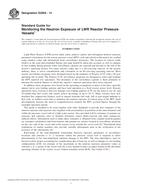
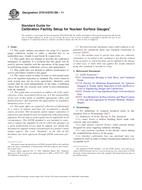 ASTM D7013/D7013M-11..
ASTM D7013/D7013M-11..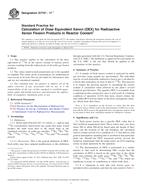 ASTM D7727-11e1
ASTM D7727-11e1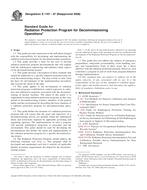 ASTM E1167-87(2008)..
ASTM E1167-87(2008)..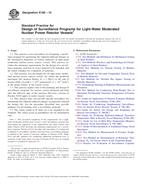 ASTM E185-10
ASTM E185-10 ASTM E2005-10
ASTM E2005-10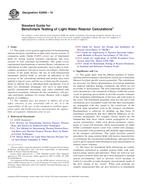 ASTM E2006-10
ASTM E2006-10
 Cookies
Cookies
